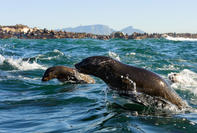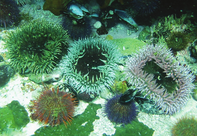Dive Sites Range
False Bay offers the diver such a variety that it is difficult to classify this coastline as any particular ‘type’ of diving. Dive sites range vastly in bottom composition depending on where in False Bay you choose to dive.

It fluctuates from rocky terrain characterised by the steep cliffs on the western side of False Bay through to sandy bottoms on the eastern side. A number of sites on both sides of the bay are distinguished by vast, dense and beautiful kelp forests that house any number of creatures such as Pyjama sharks, Leopard catsharks and Puffadder shysharks. Kelp forests act as a filter for dirty water so divers will often experience mediocre conditions until entering the kelp whereupon the visibility improves dramatically. The Gordons Bay, Rooiels and Simonstown sites boast spectacular Sea fans in bright oranges and reds which sway in the surge – another defining characteristic of dive conditions in the Cape.
The friendly Cape fur seal will often make an appearance on your dive. It might just be a fleeting glimpse but more often than not, your new dive buddy will hang around for some time. The sheer curiosity of the younger ones will have them diving in and out of your group and often imitating your movements. Be sure to keep your fingers well out of harm's way as they have been known to bite. Divers will seldom see bare rock as every nook on the reefs are carpeted by sea anemones of all colours imaginable.
Furthermore, Feather stars in various hues of orange and brown vie for space with soft corals in pinks and purples, making it a difficult, yet very rewarding task to spot the many Nudibranchs endemic to this region. Box jellyfish are abundant throughout the Cape waters and a dive in Gordons Bay will seldom go by without a sighting of the Root-mouthed jellyfish.
Launch Sites

The Rooiels dive spots are typified by very large Orange sponges whereas Smitswinkel Bay, accessible via a boat launch from Millers Point in Simonstown, is renowned for its fantastic wreck diving. All the wrecks lie beyond basic Open Water qualifications so advanced certification is a must for divers wanting to explore scuttled navy vessels from yesteryear.
The eastern side of False Bay is predominantly divided during the summer months due to the strong south-easterly winds which blast the dirty surface water out of the bay. In contrast, the western shoreline is a winter dive destination when the cold frontal winds create cool, yet very clear conditions. Although, the unpredictable nature of Cape Town often allows a respite from these rigid guidelines, allowing divers to enjoy unseasonably great diving along both shorelines.
There are a variety of types of entries at False Bay. Most of them are shore entries although some of the dive sites can only be reached by boat. The boat launches will take place from the closest harbour or from the closest launching ramp to the dive spot.
 False Bay is so named because many sailors returning from the East used to mistake Cape Hangklip (near Hermanus) for Cape Point. As a result...
False Bay is so named because many sailors returning from the East used to mistake Cape Hangklip (near Hermanus) for Cape Point. As a result... Self drive routes from Cape Town invite visitors to the Mother City to experience the natural splendour, fun activities and scenic attractio...
Self drive routes from Cape Town invite visitors to the Mother City to experience the natural splendour, fun activities and scenic attractio...